|
PROJECTS | Exhibition DIVA at Škuc Gallery
1. EXHIBITION CONCEPT AND CONTENTS |
- Curatorial platform
A study exhibition entitled DIVA at Škuc Gallery showcased the DIVA Station archive of SCCA-Ljubljana, presenting it as a 'live archive'. It includes an educational programme, practical demonstrations, theoretical contributions; representative video works, curatorial selections and international collaboration, and also presents theoretical, practical and artistic aspects of audio-visual archives of contemporary art.
The exhibition allowed visitors to see various processes of preservation, and the development of video equipment and shifts in the use of technology.
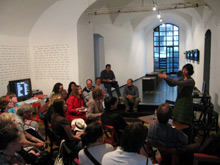
 |
- DIVA Station
DIVA Station is a physical and web archive of video art which has been developing since 2005, and is one of SCCA projects, which is focused in the research, documentation and archiving of video / media art materials: Videodokument, Videospotting, Internet Portfolio, Artservis Collection and e-archive. DIVA Station is a partner in the GAMA (Gateway to Archives of Media Art) international internet platform, which brings together European video / media archives to make them more visible and easily accessible.

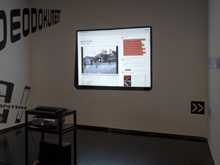
 |
- Viewing room
Video works and curated video programmes from DIVA Station were seen on several screens. In the viewing room it was also possible to see video on demand, where every visitor could view their own selection by choice. To make their choice easier, we had prepared several sections which present the DIVA Station in all its thematic and structural diversity, including overviews of individual artists, music videos, Škuc-Forum video production, Videospotting (curated selections), video and television, SCCA exhibition projects, and international video.
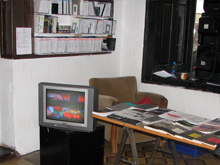
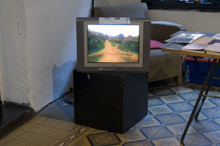
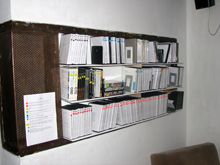
 |
- Organising the archival material
The questions concerning the organisation of the archival material were presented in the form of language based graphs under the titles:
- The carrier is unstable,
- The paradox in the conservation is copying,
- Disturbance of the signal: crystal clear sound and image,
- Classification into categories and what can not be grasped,
- The structure of input and description,
- Accessibility - invited to view,
- Random keywords.
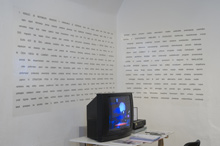
 |
- Videospotting, curated programmes
The exhibition included thematic selections from Videospotting that presented:
- chronological survey of the video from Slovenia showing shifts in understanding and usage of video as a media of artistic expression from its beginning in 1969 up until now: Videodokument presents (2006)
- video dance: Dancemania (1997), Videodance_6 (2008),
- video works which deal with the concept of time and the creatures: Creatures (1997), Creatures_2 (2003);
- video works as a combination of public and private that combine documentary and artistic approach: Private-Public (2005).

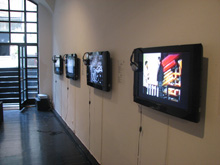
 |
- Video signal
The diagrams have shown the transfer of light energy into electrical and video signal and back into the light energy again. They presented 1) important formats for recording video signals on magnetic tapes according to the composite and component digital or analogue video signal; 2) promoters of the video signal, allowing the storage and transmission (radio frequency, magnetic tape, hard disk and memory card), and some of the video codecs; 3) light and colour values of the audio-video signal within the radio frequency fields.
Before any of the video recorders (and players) were produced, the video signal was already there and was used and marketed. The signal has been mainly used (and still is) on TV. Before the digitisation of television radio frequency (RF) was used as a transmitter of the video signal. People have bought the device (television), which was able to transform the radio signal into video (and audio) signal, and project it on the screen. As such the distribution of the product (signal) could have started. For some years, the video works could be transmitted only as a direct transmission of live events in real time. Ironically, the video at the time could only be record with a camera in a way that they recorded films on celluloid and then its reel it on the screen. The video at the time was only black and white and only years later in colours.
Simultaneously with these live screening events, they undertook developments which resulted in the creation of technology that would enable them to record (save) video in it's "natural" primary electronic form. Initially, the process of developing a video signal recorder was aimed mainly at the needs of broadcasters. The format of the video signal was (and still is) strongly subordinate to this assigned (institutional and commercial) use of video signal for the television and television programme.
Later, the development of video recorders started to have ever newer dimensions. The possibility of their use generated an increasing need for their use, what in the frame of television industry initially led to the development of different forms of video signal. When the needs for video recorders over the years escaped the boundaries of television industry, the use and products for recording video signal elevated dramatically. Consequently the number of different types of video signal also increased. In a time of general digitisation of the materials it has resulted in the transformation into the digital video signal. But we have had to deal with numerous different formats right from the very beginning.
(Neven A. Korda)
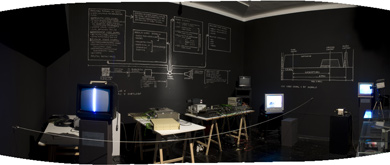
photo: Dejan Habicht
 |
- Technical equipment and examples of video carriers
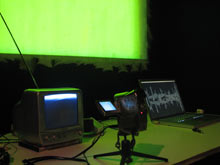
Wobble vision and interference with video signal
Luka Dekleva has developed a process for multi-media performance entitled Digital Community (2007) that was then organised by Multimedia centre Kibla. In the performance has also been using TV monitors with an external control coils (electromagnets) for vertical and horizontal deviation of electron beams in cathode ray tubes.
The work was inspired by the first (public) transformation of video signal in 1963 by Nam June Paik in the installation Exposition of Music-Electronic Television. He affected on working of coils in the cathode tube, which control the position of e-beam in the irradiation of the screen. This kind of processed TV today is called "wobble vision".
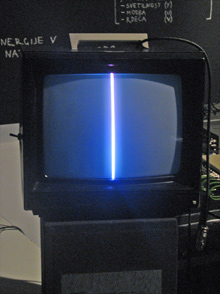
JVC GC 3300 E
Neven Korda installed in the space an insufficiently functioning camera that was designed around the end of the seventies and had been used by FV theatre (Ljubljana) as a second hand camera from 1982 onwards. The camera and processing unit for the video signal were separated. It had two vidicon tubes (blue and red), which is quite a rarity. The device also had a possibility of independent control of the luminance (white and black information: so called Y set up), and the control of the blue and red colour.
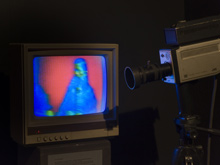
Examples of video carriers
Open Reel 2''
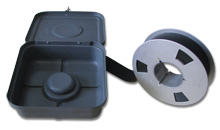
Video graphics, 1976 (from the archive of Miha Vipotnik)
VCR
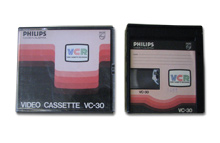
One of the tapes for Videogram 4, 1979 (from the archive of Miha Vipotnik)
VCR
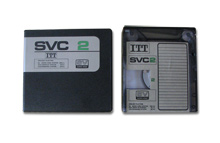
(from the archive of Borko Radešček)
U-matic hi band
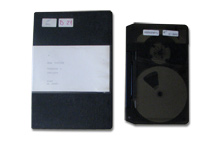
Videogram 4, 1976/79 (from the archive of Miha Vipotnik)
U-matic low band
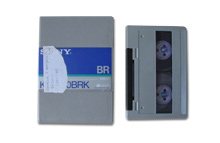
The original tape of Baptised under Mount Triglav, project of the Sestre Scipione Nasice Theatre, 1986 (from the archive of Miha Vipotnik)
Betacam
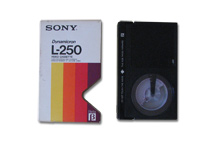
Selection of the video part of the Biennial Video CD 83 (from the archive of Miha Vipotnik)
VHS
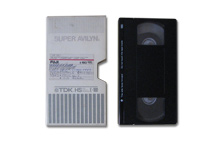
Marko A. Kovačič, Casus Belli, performance, Škuc Gallery and Biennial Video CD 83, 1983 (from the archive of Marko A. Kovačič)
Digital Beta
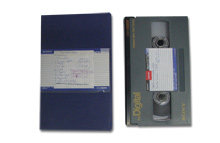
The Triumph of Will, Borghesia music band, digital copy and restored U - matic low band master, 1999 (from the archive of Neven Korda)
D5

Working material (the intermediate phase from the production of video The Old and the New), 1997 (from the archive of Neven Korda)
S-VHS
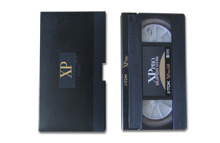
Thylacine (master), 1998 (from the archive of Damijan Kracina)
Video8
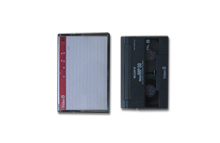
Concerto for plaster & bass, 1993 (from the archive of Damijan Kracina)
 |
- 24-hour video projections
In one of the front windows of Škuc Gallery that overlooks directly to the main pedestrian street in the old city we installed three television sets. The window attracted random stroller for 24 hours, every day of the exhibition. Displayed selections of video works which were thematically and stylistically organised in three different topics:
- REPETITION AND THE MICRO WORLD with video works by Neven Korda, Damijan Kracina, Zvonka Simčič, Robertina Šebjanič, Tanja Vujinović
- ANIMATION with works by Zvonko Čoh, Milan Erič, Marko A. Kovačič, Kolja Saksida, Vladimir Leben, Oliver Marčeta, Grega Mastnak based on the narrative
- and VISUALLY based video works by Marko A. Kovačič, Andrej Lupinc Lupo, Duba Sambolec, Miha Vipotnik.
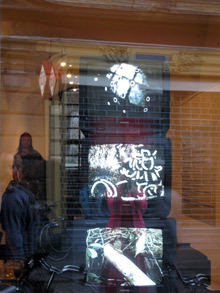
 |
- Artservis Suitcase
Artservis Suitcase was exhibited as an example of a mobile archive. Since Artservis is an internet service that helps cultural workers and deals with funding and organisation of their work, the Artservis Suitcase keeps the Artservis Collection dedicated to the theme of the production conditions in culture sphere.

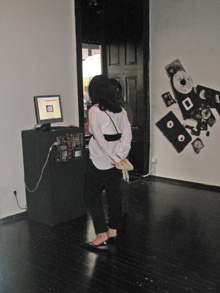
 |
|
|
|

